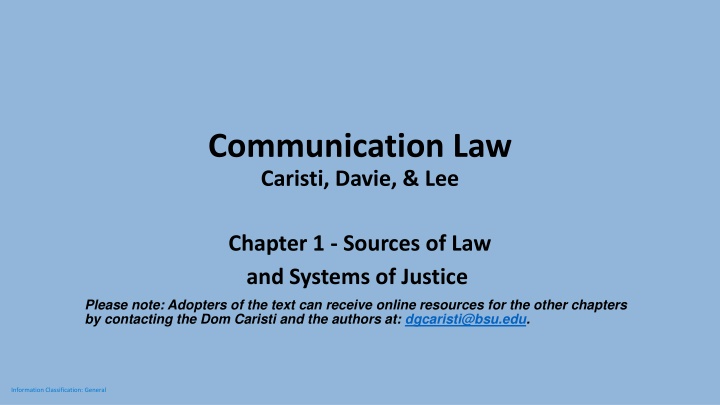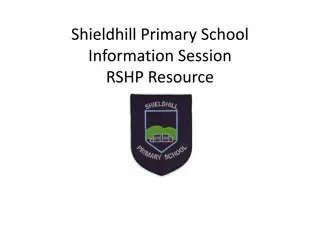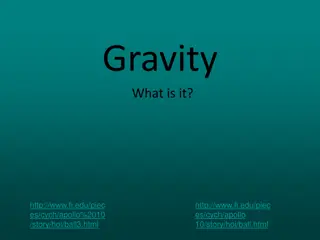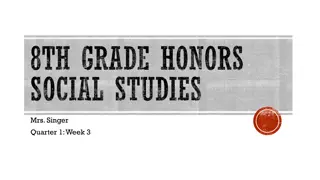
Sources of Law and Legal Systems in Communication
Dive into the foundational aspects of law and justice systems in communication through exploring different sources like constitutions, statutes, and common law. Discover the structure of legal frameworks, including constitutional provisions and state charters, while understanding the significance of statutory laws and legal precedence. Learn how these elements shape the legal landscape in communication contexts.
Download Presentation

Please find below an Image/Link to download the presentation.
The content on the website is provided AS IS for your information and personal use only. It may not be sold, licensed, or shared on other websites without obtaining consent from the author. If you encounter any issues during the download, it is possible that the publisher has removed the file from their server.
You are allowed to download the files provided on this website for personal or commercial use, subject to the condition that they are used lawfully. All files are the property of their respective owners.
The content on the website is provided AS IS for your information and personal use only. It may not be sold, licensed, or shared on other websites without obtaining consent from the author.
E N D
Presentation Transcript
Communication Law Caristi, Davie, & Lee Chapter 1 - Sources of Law and Systems of Justice Please note: Adopters of the text can receive online resources for the other chapters by contacting the Dom Caristi and the authors at: dgcaristi@bsu.edu. Information Classification: General
Understanding rule of law Defining different sources Learning Objectives Legal enforcement through different systems Outlining methods for study of principles and procedures Information Classification: General
Rule of Law Equal enforcement for all persons Protection of free expression (TikTok case) Safeguards for security and access Information Classification: General
Sources of Law Constitutions charters of governance Statutes legislative acts Administrative regulations agencies and offices Executive orders temporary mandates Common law judge-made law Information Classification: General
Constitutional Structure Preamble, articles and amendments Co-equal branches with separate powers Legislative Executive Judiciary Bill of Rights (1791) Ten amendments ensuring essential freedoms (followed by 17 amendments) Information Classification: General
State Charters of Government Fifty states follow constitutions Resemble federal charter in communication terms Checks and balances for three branches Legislatures rely on executive concurrence and enforcement Judicial branch reviews acts of all branches Information Classification: General
Statutory Law Laws created through legislatures usually signed by executive (president or governor) Executive veto of legislative acts subject to override Statutes organized into codes; indexed by titles Bound together under common topics for code books U.S. Code Title 17: federal protection of music, videos, books, movies, and other intellectual property Information Classification: General
Precedence based on adherence to rulings established in previous and similar cases Judicial decisions to uphold constitutional rights and strike flawed laws Workings of Common Law (Judge-made Law) Laws struck for overbreadth or vagueness Terms and wording too unclear and indefinite to give fair notice Information Classification: General
Court System Fifty-two court systems federal, state, and District of Columbia District courts handle cases at trial court level Appellate courts review questions of law Court of last resort usually a supreme court Information Classification: General
Executive Orders Directives by president or governor to execute an act Carries force of statutory law for indefinite period Limited to executive s term in office or longer, depending on successor s action Information Classification: General
Administrative Law Self-administration Federal or state agencies given power to draft, enforce, and rule on appeals of regulation Judicial review Rulings by FCC, FTC, SEC subject to appeal in federal court State agency rulings subject to appeal depending on state Information Classification: General
Equity Law Affords just and fair remedy to resolve disputes when tort or criminal laws do not apply Remedies granted by judicial decree to perform a duty or refrain from actions deemed unlawful No monetary damages, but orders decreed to meet an obligation or cease and desist activity Information Classification: General
Systems of Justice - Civil suits Civil suits and and Criminal trials Criminal trials Civil Law: Used to rule on disputes between private parties Lawsuits based on contracts or torts, covering legal promises and/or duties to others Criminal Law: Defines conduct prohibited and punished by the state as a threat to society Arrive at court through citation, arrest, or grand jury indictment Information Classification: General
Administration of Justice All facts and evidence between parties shared to determine harms, suffered losses, or accountability Burdens of proof and standards of fault Criminal judgment: guilty vs not guilty Civil outcome: usually preponderance of evidence Information Classification: General
Plaintiff: Aggrieved party brings cause of action Cause of action: Offense for the civil lawsuit usually framed as a tort Terms of Civil Law Defendant: Accused party in lawsuit Liability: Responsibility for legal offense/harm (Guilt not a term to use in civil lawsuits) Damages: Punitive or Exemplary damages Special and Compensatory Information Classification: General
Prosecution: Government action against subjects charged with a crime Crime: Act or offense in violation of laws enacted for general public s protection Terms of Criminal Law Defendant: Accused subject charged with committing a crime Guilty verdict: Person convicted of crime beyond reasonable doubt Penalty: Fine, imprisonment or both Information Classification: General
Petitioner/appellant -- Losing party seeking appeal based on reversible error Respondent/appellee -- Responding party seeking to uphold lower court s ruling Discretionary review -- granting certiorari Courts of Appeal Appellate court ruling -- rendered on application of law and finding of error Court of last resort Supreme court in U.S. and most states Information Classification: General
Seven Elements for Briefing a Case Citation Facts Issue(s) Decision Rationale Rule of Law Concurring or Dissenting Opinions Information Classification: General





















